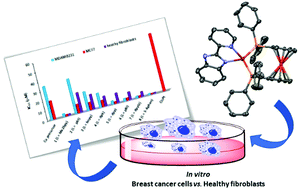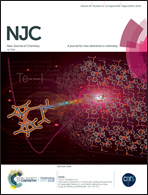First heterobimetallic Cu(i)–dppf complexes designed for anticancer applications: synthesis, structural characterization and cytotoxicity†
Abstract
A new family of eight heterobimetallic Cu(I)–dppf complexes of general formula [Cu(dppf)L][BF4] with dppf = 1,1′-bis(diphenylphosphino)ferrocene and L representing N,N-, N,O- and N,S-heteroaromatic bidentate ligands have been synthesized and fully characterized by classical analytical, spectroscopic and electrochemical methods. The single crystal structures of [Cu(dppf)(pBI)][BF4] (6), [Cu(dppf)(dpytz)][BF4] (7) and [Cu(dppf)(5-Aphen)][BF4] (8) complexes (where pBI = 2-(2-pyridyl)benzimidazole, dpytz = 3-(2-pyridyl)-5,6-diphenyl-1,2,4-triazine and 5-Aphen = 1,10-phenanthrolin-5-amine) were determined by X-ray diffraction studies. Cytotoxicity of all complexes was evaluated in two human breast adenocarcinoma cell lines (MCF7 and MDAMB231). All the complexes exhibit high cytotoxicity against both human breast cancer cells with IC50 values far lower than those found for the antitumor drug cisplatin in the same cell lines. The IC50 values on primary healthy fibroblasts are of the same order of magnitude as those found for the tumoral cells.



 Please wait while we load your content...
Please wait while we load your content...